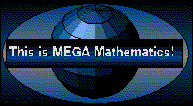


A real-world situation has a tremendous potential for variation and an enormous amount of detail. A real-world object is too unwieldy a thing to be studied mathematically.
Thus, the lines of Euclidean geometry have length only, and no breadth or depth.
"Three" is an abstract idea, not a concrete thing in the real world, but "three" is a very useful abstraction, because it allows us to be certain of how many "three" represents, and that adding one more will produce "four", whether we are talking about cupcakes, toasters, or barrels of oil.
The graphs that serve as the game boards for the stories about Gertrude, Superperson and the Monster are abstractions because they are not true pictures of the land in which they live, but only pictures of the aspects of their land that are relevant for experimenting with the ideas in the stories.
In many cases the departure from the real world into the abstract world of modeling does not seem particulary troublesome---in fact it is useful, and part of our everyday thinking. It is always important, however, when a model is extracted and the its objects analyzed, manipulated, and reapplied to the real world that we think about the ``fit''. Features that were disregarded when the model was extracted may turn out to have been important in ways that were unforseen. It does not always follow that what is true mathematically from a model extracted from the real world will also be true in the real world.


